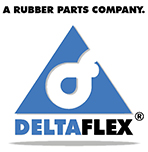Forces and motions are the elements utilized by mechanical equipment to perform useful work. Unfortunately, these same elements can produce undesirable effects, even in the most carefully designed equipment. The adverse effects of vibration, shock and noise disturbances range from simply annoying to shortened equipment life through premature failure of its components. They will affect comfort, safety or performance Vibration , shock and noise control components, properly applied, will improve your products. They will operate more smoothly, more quietly, be less disturbing to surrounding equipment and personnel , be less susceptible to damage and frequently less expensive to make. As such , bonded rubber mounts provide cost-effective solutions to problems involving vibration, shock and structural noise control as well as reduce stress and the need for close tolerances.
To solve problems involving unwanted disturbances, first locate the source of the disturbance and determine its cause - tolerance build-up, unbalance, wear, speed of operation, method of power generation, operating conditions etc. Second, determine what kind of disturbance-shock, vibration, noise - you are dealing with. And third, measure the amplitude of the motion, the static and dynamic loads, the location of the center of gravity, the frequency of the disturbance and the location of probable attachment points. If any of the information is not obtained often useful values can be estimated. Our applications engineers can help you with these estimates, based on their knowledge and past experience. Finally, what is the interaction between the disturbing element and whatever it is that's being disturbed: a machine, for example, might be transmitting a disturbance through its support to the floor. Or it might be transmitting a disturbance to the device it is driving. Whether it is a mechanical device or the support or structure against which the disturbing element operates, you need to know the allowable loads and motions that it can tolerate.
The theory and concepts for bonded rubber mounts are relatively straightforward. However,component selection or design may be complicated because some vibration , shock and noise control problems are quite complex. These applications need the involvement of specialists in order to arrive at suitable recommendations. Lord Corporation has a technical staff available to assist you. A great many of the applications are reasonably uncomplicated and the nonspecialist designer can deal with them directly. In any event, the information given in this catalog will prove useful whether you are designing or preparing to seek assistance This has been prepared to assist the individual who doesnot frequently deal with vibration, shock and noise problems or to remind others of the versatility of bonded rubber mounts. It presents the important information needed to select and use bonded rubber mounts: possible problem areas, a little theory, ideas on how to apply mounts and some data on standard mounts.
At this point, consider these important principles which will make the mounting system chosen most effective. The closer to the source that the protecting element can be placed, the better and simpler the solution becomes. If the location for the mounts is not determined as a result of the equipment design, it is desirable to locate the mounts equidistant from the center of gravity and to have the mounting plane pass through the center of gravity. Generally, it is desirable to use the smallest mount that will carry the load and control the disturbances. Small mounts offer lower cost and space savings.
Theory
The theory that follows is intended to provide an understanding of how a bonded rubber mount functions. The behavior is much like a spring with added damping. For the purpose of this explanation , a bonded rubber spring differs from the classical spring primarily in that an elastomer (rubber) is used. This provides a single package with controlled resilience (spring) and hysteresis (damping) resulting from the molecular structure and compounding of the elastomer
The theory section schematically separates the two properties, spring and damping, in order to explain how they contribute to the desired results obtained from properly applied rubber springs The figure to the right shows the symbols used. Although both properties are always present, the theory will sometimes deal with them one at a time. In those cases the property emphasized will be shown in solid line and the other property will be shown in dashed line.
